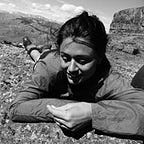Does this count as nature?
Head east from Stanford campus, and you’ll find an almost-beautiful place, one that’s flat and scarred and naturally productive, if not quite natural. To the west, of course, lies the iconic Californian magic of redwoods, rolling golden grasslands, stern Pacific views. But one evening this fall, after meandering through well-tended suburbia, across 101 and its web of on-ramps, I reached the edge of San Francisco Bay at sunset. A different sort of magic.
I’ve returned many times, circling trails while smelling the curious mix of salt, mud, blooming plants, sewage treatment plants, bird shit. I’m preoccupied plotting a post-graduation return to “wild” Patagonia, to those immense and perfect landscapes where I worked for five years before grad school. But this very imperfect place brings me back to hunting out corners of space as a Manhattan kid. A metal swingset in a paved park, where the top of the swing brought the river into view, deserved hours of attention each afternoon. What counts as nature?
